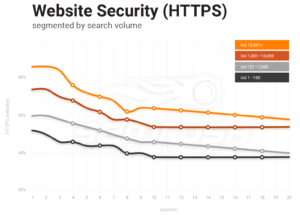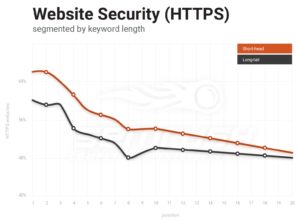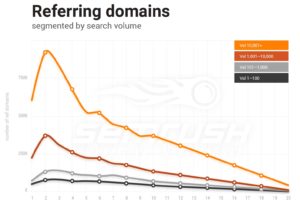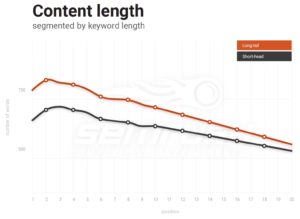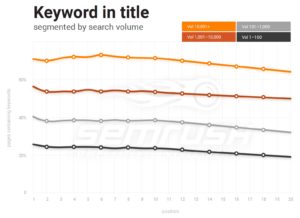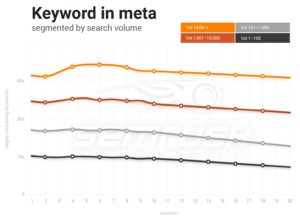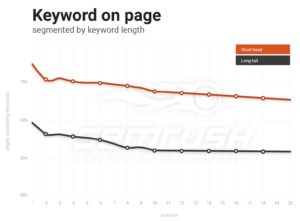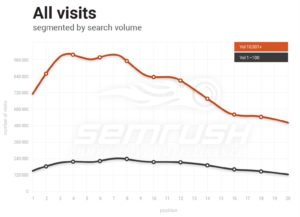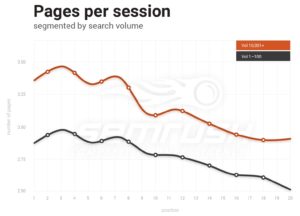SEMRush 2017 SEO Ranking Factors

Let’s face it, as digital marketers there’s one question we all strive to understand…what is the exact criteria required to rank organically on page one in Google?
Unfortunately, this quest for SEO knowledge eerily mirrors the path to unlocking the secrets of the human brain. Despite constant new discoveries, the journey requires on-going research, vast amounts of data, and unwavering dedication, yet somehow the full picture remains shrouded in secrecy.
Despite the challenge, SEMRush has conducted a comprehensive analytical study, outlining the top organic search ranking signals based on the Google SERP results across 600,000 search queries. The analysis works to pick apart Google’s secret sauce and pinpoint the most impactful factors in improving overall rankings. The SEMRush report focuses on the following ranking factors:
- Website security
- Referring domains
- Content length
- On-page SEO elements
- Website visits
- User behavior signals
Website Security
Over the years, Internet security has become a critical component to safeguarding businesses of all sizes from cyber attacks and identity theft. Google has taken this notion to heart, taking actionable steps to create a more secure web, including a public announcement in 2014 that site security will be used as a ranking signal.
SEMRush sought to understand the percentage of rankings within the top 100 positions that were HTTPS among the 600,000 keywords studied, while taking into consideration both keyword search volume and keyword length.
Summary of Findings:
- Higher search volume keywords had a greater of number of HTTPS sites ranking across all positions.
- Higher positions showed a greater percentage of HTTPS sites ranking, independent of keyword search volume.
- Higher positions showed a greater percentage of HTTPS sites ranking independent of keyword length.
- Positions ten and above show the steepest rise in HTTPS site rankings for long tail and short head keywords.
- Long tail terms have a lower percentage of HTTPS site rankings in comparison to short head.
Takeaways:
The more popular a keyword is, the greater the likelihood the top positions will be occupied by HTTPS sites. As the HTTPS adoption rate continues to increase, HTTP sites will find it increasingly difficult to rank on page one in Google. Currently there is more opportunity for HTTP sites to rank for long tail keywords, however this trend may change over the coming year.
Bottom line, if you want to maximize your chances for page one rankings for any keyword, regardless of search volume and keyword length, it is highly recommended to migrate your site to HTTPS.
Referring Domains
We all know backlinks are essential to improving organic search rankings, and as Google’s algorithm continues to grow in sophistication and intelligence, you must put your best foot forward when it comes to generating a high volume of quality backlinks to your website. But what about the diversity of these links?
SEMRush evaluated search queries with various search volumes to understand the correlation between a website’s number of referring domains and the page position in search results.
Summary of Findings:
- Higher ranking pages have more backlinks from unique domains.
- Websites ranking for high volume keywords have approximately 10x more referring domains than low volume keywords.
- There is a large variance in the number of referring domain between positions for high volume keywords.
Takeaways:
While the quantity and quality of backlinks are essential to maximizing rankings, diversity also plays a significant role for high volume keywords. You should ensure you are receiving backlinks from a large number of reputable domains to diversify your “backlink portfolio” if you wish to stand a chance of ranking on page one for high search volume keywords. For smaller websites, you should consider targeting high intent, lower search volume terms as you continue to grow the number of backlinks to your site.
Content Length
In an age when content is king, marketers have never had to work so hard to generate fresh, relevant, and engaging content to compete for their audience’s attention. Unfortunately, creating impactful content can be time consuming, especially when added to existing workloads. Therefore, you probably find yourself asking the question, “How much do we need to write?”
SEMRush analyzed content length, search volume, and keyword length to understand if there is a correlation between content length and a page’s position in the organic search results and uncovered some interesting findings.
Summary of Findings:
- The higher the page rank, the more content the page.
- The more search volume a keyword has, the longer the content on the ranking page.
- content length for pages ranking 1-10 on high volume terms is between 600 and 800 words.
- There is approximately 20% more content on pages ranking for long tail vs. short head terms.
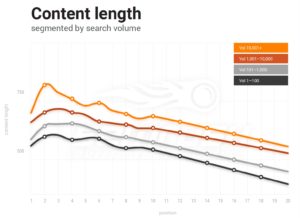
Takeaways:
Length of content definitively plays a role in rankings, regardless of search volume and keyword length. However, longer content is more important for long tail vs short head keywords. This is likely due to longer tail being more descriptive, which therefore requires more content to adequately relate to the search query.
It’s important to note that content length is NOT the only factor when analyzing the value of a page’s content. Simply creating content with the right number of words won’t result in high organic rankings. You should prioritize creating captivating content and then optimize to the proper length if you wish to maximize your page’s ranking potential.
SEO On-Page Elements
Misguided marketers stuffing keywords into content to improve ranking potential is thankfully something we don’t see as often anymore. Instead, you should strategically incorporate your target keywords into your content where it adds value to the reader…but does keyword volume on the page move the needle?
SEMRush examined search queries with various search volumes to gain valuable insight into whether the presence of keywords within a page’s on-page elements including title tags, meta descriptions, and on-page copy, influences its rankings.
Summary of Findings:
- Title Tag
- The higher a keyword’s volume, the higher the percentage of pages that include the keyword in their title, regardless of position.
- 70% of pages that rank for high volume terms include the target keyword in the title tag.
- Only 20% of pages that rank for low volume keywords include the target keyword in the title tag.
- Meta Description
- Including the target keyword within the meta description does NOT have a significant impact on positioning.
- Less than 50 percent of the pages that rank for high-volume keywords and 15% of those that rank for low volume keywords have a keyword in their meta description. (Author’s Note: Google announced many years ago that meta description text was not factored into its ranking algorithm.)
- On-Page Copy
- Pages that rank for short head keywords repeat those keywords more often than pages that rank for long tail keywords.
- Pages that rank in top positions (for both longtail and short-head) incorporate more target keywords than all other pages.
Takeaways:
Incorporating the target keyword into the title tag and on-page copy is essential to ranking in top positions for high volume keywords. Over 75% of pages in the top 20 positions include the target keyword on the page, while 60% include it within the title tag.
If you’re trying to rank for lower search volume terms, including the target keyword is less crucial as only a little more than 25% of the top pages include the keyword on the page, and less than 20% within the title tag.
It’s also important to note, you should create keyword themes around your target keywords rather than simply using the exact keyword throughout your page elements. Google identifies this as more natural and relevant, and it minimizes instances of penalties for perceived keyword stuffing (which you should never do in any case).
Website Visits
Is there any brand out there that doesn’t want to generate tons of traffic to its website? Of course not, everyone loves site traffic, but how does this traffic affect organic rankings? SEMRush reviewed organic rankings to understand how total site traffic (excluding organic) and unique visits influence page rankings.
Summary of Findings:
- Pages ranking for high volume keywords have 2-3x more unique traffic than pages rankings for low volume keywords.
- Pages with more unique traffic have higher organic rankings.
- Total site traffic does NOT have a significant impact on organic rankings for low search volume keywords.
- First page rankings have the highest site traffic for high search volume terms.
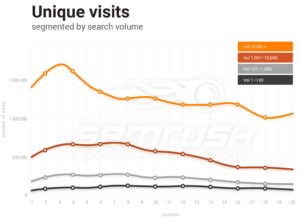
Takeaways:
Generating unique traffic will improve rankings for both low and high volume search terms. However, high search volume keywords require significantly more traffic than low volume terms. Overall site traffic on the other hand is of paramount importance for high volume terms ONLY. This indicates that Google prioritizes websites with more domain authority for high volume queries.
In turn, marketers should focus on driving site traffic through a variety of marketing channels in an effort to increase the likelihood of ranking for popular keywords.
User Behavior Signals
It’s not all about using the right keywords, how much content you write, or even how much traffic you generate. It’s about how your audience engages with your site. Site engagement metrics provide Google with a pulse on the quality of content and site architecture. What does this mean for marketers? For those who write quality content for their target audience…nothing. For those that write just to get content out the door…everything.
SEMRush analyzed rankings for terms with various search volumes to gain insight into how user engagement metrics such as bounce rate, time on site, and pages per session influence organic rankings.
Summary of Findings:
- The higher position, the lower the bounce rate.
- Bounce rate for top positioning for keywords independent of search volume is approximately 50%.
- The longer users stay on the page, the higher the page ranking.
- Time on site required for position one rankings for low search volume is approximately 40 seconds less than high volume terms.
- More pages per session result in higher rankings for both low and high volume terms.
- Low volume terms require approximately ½ a page less per session than high volume.
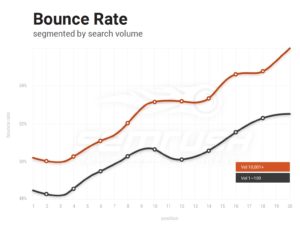
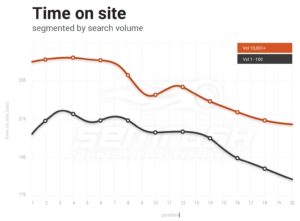
Takeaways:
Although Google has not publicly announced that all user engagement metrics contribute to ranking performance, data indicates they play a critical role for maximizing rankings for both low volume and high volume search terms.
You should take the time to create relevant and engaging content that is of value to searchers while ensuring your site is optimized for usability.
–
In conclusion, take each of these organic search ranking signals into consideration and properly optimize your website and content, putting your best SEO foot forward to maximize your potential to rank on Google page one. While secrets to Google’s algorithm still remain, SEMRush’s analysis helps to provide insight into significant opportunities to improve your organic rankings.
